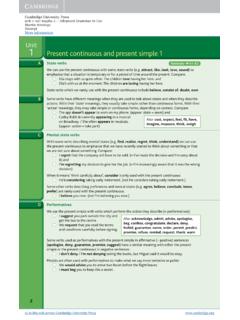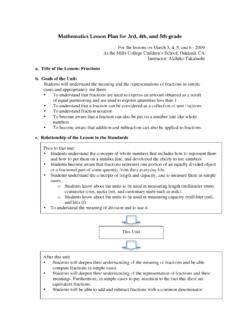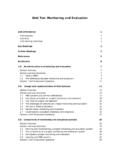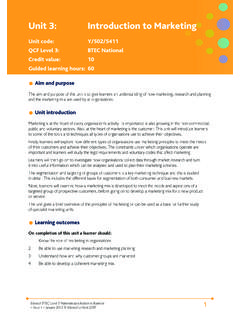Transcription of UNIT 9 INTERPERSONAL ISSUES, Interpersonal …
1 INTERPERSONAL Issues, communication and Conflict unit 9 INTERPERSONAL ISSUES, communication AND CONFLICT Objectives After studying this unit you should be able to: appreciate the importance of INTERPERSONAL issues involved at work, understand the impact of personality differences on INTERPERSONAL relationships, be more aware and understanding of others behaviour to get along better with people with different INTERPERSONAL styles, understand importance of INTERPERSONAL communication and avoid barriers, actively listen and obtain feedback to understand others and to build rapport, read nonverbal signals to improve communication , identify factors that contribute to conflict to enhance INTERPERSONAL relations. Structure INTERPERSONAL Relations Factors Affecting INTERPERSONAL Relations Towards Enhanced INTERPERSONAL Relations communication Barriers to Communications Effective communication INTERPERSONAL conflicts Summary Self-Assessment Questions Further Readings INTERPERSONAL RELATIONS Performance of members of any organization depends on their ability to effectively interact with their superiors, subordinates and coworkers within the organization and consumers, suppliers and general public outside.
2 INTERPERSONAL relations, therefore is a very important issue involving any organization? Most organizations have people problems rather than business problems. People problems are due to faulty INTERPERSONAL relations, which hinders the attainment of organizational goal. Efforts are therefore made to enhance the INTERPERSONAL skills of the people at work. FACTORS AFFECTING INTERPERSONAL RELATIONS Based on past experience people make assumptions about the nature of the other and of the particular kind of situation they are in ( Competition or Cooperation). Each person develops positive or negative feelings that contribute 5 6 INTERPERSONAL Processes 1. 2. 3. 4. 5. to enhanced or diminished perceptions of self, the other and the current situation.
3 These perceptions contribute to evaluation of the other person in this situation and lead to the formulation of intentions to interact in specific ways to accomplish personal objectives. The consequences of that behaviour and subsequent interactions generate new inputs for another set of reactions. Personality Factors When trying to understand your feelings and behaviour, it helps to be aware that how you think and feel about yourself and others may be very unlike how they think and feel about themselves and you. These different evaluation and reactions depend on each individual's self-concepts, value system; frame of reference, defensiveness, INTERPERSONAL relationship needs and feelings.
4 (i) Self-Concept: Self-concept is a reflection of all the past experiences one has with others and includes characteristics which differentiates from others. Once self-concept is established and certain specific patterns of behaviour are adopted, it tends to resist change. In order to maintain INTERPERSONAL environment and to maximize congruence of harmony, certain mechanisms are used. Misperception: Misperceiving how others look at you. Selective Interaction: Interact with those persons who can establish a congruent state Selective Evaluation of the other person Selective Evaluation of self Response Evocation: Behave in a way that results in others behaving towards you in an amicable manner. (ii) Personal Frame of Reference: Self Concept and perception of other people and things develop into a personal frame of reference for perceiving and interpreting experiences.
5 Two people with different frames of reference may do very different things in the same situation to try and satisfy the same need. Different needs, past experience and cultural backgrounds are a frequent source of different frames of reference. In the present business scenario where people from different culture most often work together in the same organization frame of reference enjoys a lot of importance. To understand others, one needs to understand their frames of reference without judging them in terms of one's own values. (iii) Defensiveness: Defense is a cognitive distortion that projects the self-concept against being diminished. It occurs when one protects him or her by denying, excusing or rationalizing one's action to protect self-concept against the threat of being damaged by failure, guilt shame or fear.
6 Defense mechanisms affect the way individuals relate to each other and the way they understand and adopt to their relationships. Defensiveness may distort ideas, obscure solutions and hinder INTERPERSONAL relations. One way to avoid defensive behaviour is to acknowledge what is being said as at least partially true. List of Common Defense Mechanism 7 INTERPERSONAL Issues, communication and Conflict Defense Psychological Process Rationalization Justifying behaviours and feelings that are undesirable by providing explanations that make them acceptable. Repression "Forgetting" painful and frustrating events by unconsciously putting them out of your memory.
7 Reaction-Formation Repressing unacceptable urges and exhibiting the opposite attitudes and behaviours. Projection Protecting yourself from awareness of your own undesirable traits or feelings by attributing them to others. Regression Regression Responding to frustration by reverting to earlier and less mature forms of behaviours; attempting to go back to a more comfortable time. Displacement Redirecting pent-up emotions toward persons other than the primary source of the emotion. Compensation Engaging in a substitute behaviour to make up for a feeling of inadequacy. Denial Refusing to absorb threatening information. Withdrawal Physically or mentally leaving a situation that produces anxiety, conflict, or frustration.
8 Resignation Withholding any sense of emotional or personal involvement in an unpleasant situation. Counter dependence Suppressing feelings of dependence and expressing hostile independence. Aggression Instigating a hostile attack on another because you are frustrated or uncomfortable. (iv) INTERPERSONAL Relation Needs: People have three nominal INTERPERSONAL heads: Inclusion: Inclusion is the need to establish and maintain relationships with other people. It concerns balancing the desire to be part of a group against the desire for solitude. Control: Control is the need to maintain a satisfactory balance of power and influence in relationship. It concern trade-offs between the desires for structure and authority versus the desire for freedom.
9 Affection : Affection is the need to form close and personal relationships with others. It concerns balancing desires for warmth and commitment against those for maintaining distance and independence. Each of these three needs has two sub dimensions - the expressed towards others and wanted from others. Behaviours Expressed towards others wanted from others Figure 1: INTERPERSONAL Relationship Orientations Inclusion Control Affection I want others to join me I take charge and influence others I get close toothers I want others to include me I want other to lead me I want others toget close to me If you have strong INTERPERSONAL needs you desire to interact with others are of gregarious nature.
10 If you have low INTERPERSONAL needs you do not mind being alone and are more reserved. It has implication on ones INTERPERSONAL relation and also in career choice. Marketing and Human Resource majors need to have stronger INTERPERSONAL needs than those in accounting and system analysis. 8 INTERPERSONAL Processes The degree of need compatibility between two or more people can Make the difference between a happy and productive team and a dissatisfied and ineffective one. If one person has a high need to control and another has a high need to receive direction, they are likely to get along well. On the other hand, if they both have high needs to express control and low need to receive it, conflict is likely to occur.






